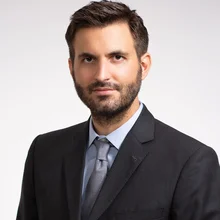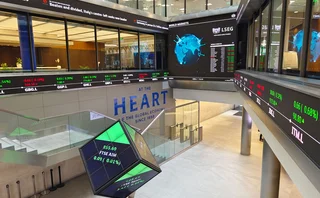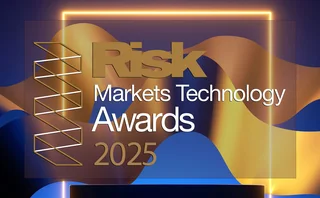
Equity derivatives house of the year: UBS
Asia Risk Awards 2024

In early February, turmoil in China’s onshore equity market prompted some banks to pull back from market making on options linked to A-Share stock indexes. UBS was one of the few banks that remained fully open for business on China stock options throughout the turbulence.
A sell-off in China stocks turned into a huge rout as structured product issuers and quantitative funds onshore stampeded to exit hedging positions. But, amid skyrocketing volatility, UBS was able to transfer the risk through pricing collaboration between delta one and group equity derivatives teams. That allowed the Swiss bank to continue making prices on options, and help clients buy the dips.
“When the ‘quant quake’ happened in February, clients needed solutions to hedge their exposures on Hang Seng, CSI 500 and CSI 1000,” says Fabien Falipou, head of risk and trading, Asia-Pacific, at UBS. “Our integrated platform allowed us to provide a very high quality of service during the period and resulted in an increase in market share.”
In a year of big changes at UBS following the acquisition of Credit Suisse, the bank’s navigation of the China stock slump underscores the resilience of its equity derivatives franchise in Asia-Pacific.
UBS’s onshore presence also provided a competitive edge as the turmoil unfolded. The bank has an onshore securities joint venture that is active in onshore retail structured products, and it is the only international bank with a licence to participate in the market. UBS’s business includes the issuance of ‘snowball’ products linked to the CSI 500 index; products that came to be centre stage in the sell-off.
Delivering annualised coupons as high as 20%, these autocallable-like products – containing upside knock-out and downside knock-in barriers – exploded in popularity during a sustained bull market for China stocks beginning in 2019. By 2022, however, China’s stock market had entered into what would turn out to be a sustained bear market amid weakening economic fundamentals. Existing products were no longer quickly knocking out as they had done before, and new sales of the products began to suffer.

The situation would then come to a head in late January this year when, after a fresh wave of selloffs, products began to hit knock-in barriers. These knock-ins led to issuers dumping index futures hedges, and the tumbling futures in turn fuelled more pessimism driving spot down further. Early next month, quantitative funds’ market-neutral strategies then became a casualty after state funds stepped in to support the market but inadvertently caused large and mid-cap stocks to diverge from small caps.
UBS’s equity derivatives team in Hong Kong had been alerted early on to what was happening with snowball products by the bank’s onshore securities venture. So, when the unravelling chaos in the market began to gain global attention, UBS became the go-to bank for clients looking to trade on it.
Shane Carroll, equity derivatives analyst at UBS, says through that period the bank dealt with a deluge of enquiries from clients all around the world on China equity derivatives trades.
“We were able to get an early understanding of the snowball dynamics due to UBS’s strong presence onshore, being the only international bank with an onshore derivatives licence in running a snowball book,” Carroll says. “We also have a strong delta one franchise, which is key for being able to facilitate that flow to international clients. And we worked with our options trading desk to create trade ideas on the back of it.”
During this period of volatility, the A-Shares traded on UBS’s offshore platform surged, with the majority of the volume on the delta one swap side of the business.
Going market-neutral
The fallout from China’s stock selloff has not been limited to the domestic structured products market. For more than 10 years, the Hang Seng China Enterprises Index (HSCEI, which tracks mainland securities listed in Hong Kong, was a popular underlying in the autocallable products that dominate South Korea’s retail structured products market. This market had been a big business for international banks, who along with local securities houses, acted as issuers of the products as well as helping product distributors to hedge the exotic risk exposures on their books.
At the end of 2023, however, Korea’s financial regulator launched a probe into HSCEI-linked products after the China selloff left investors facing the equivalent of billions of dollars of losses. Product issuance has since been muted, with many distributors pulling back from the market. Asia’s other big market for retail structured products, Japan, suffered a similar fate after a 2022 regulatory crackdown.
For UBS’s equity derivatives franchise the decline of these two retail structured products markets has been less material than for some of its global bank competitors in the region. One of the reasons for that is wealth management, private banking and distribution activities have long dwarfed retail structured products in terms of importance to the bank’s equity derivatives business in Asia-Pacific.

“The two big markets [for retail structured products], Japan and Korea, have been pretty quiet,” says Romain Barba, co-head of structuring, Asia-Pacific, at UBS. “So, in that environment our focus on serving wealth managers – in Hong Kong, Singapore particularly – puts us in a very good position.”
One solution that won praise from clients in the private banking and distribution space, showcases both UBS’s high-quality in-house equity markets research and mastery in developing new payoffs. The ‘Rainbow’ Dispersion product is a market-neutral strategy that involves buying a call option on dispersions of several baskets of stocks. UBS leveraged its research capabilities to select stocks for the baskets on the basis of various topical themes such as AI or the US presidential election.
These Palladium trades are not new. But the UBS’s Rainbow Dispersion variation came a new twist on the traditional payoff. In a typical basket for a dispersion trade, any one exceptional name can drive a majority of the dispersion in the basket due to idiosyncratic events related to that specific name only. The Rainbow Dispersion moves the weight of the least dispersed name to the highest dispersed name, which can significantly improve the payout depending on the movement of the most dispersed trade. The bank gave it the name Rainbow Dispersion because the payoff works in a way similar to that of rainbow call options, which reference the best or worst performer of the assets involved.
“This tweak to our dispersion product really enhanced the performance for the client,” says Falipou. “It’s the combination of two [elements]: first, a strong theme, which makes it attractive to the client and easy for the intermediary to distribute; and second, a modification of the classic payoff that enhances the attractiveness of the economics if the view is right.”
UBS has also demonstrated again this year why it is one of the region’s go-to banks for quantitative investment solutions (QIS). In partnership with technology and data-science specialists Second Foundation Partners, the bank recently developed a new suite of equity market-neutral strategy. The UBS ETNA Market Neutral Strategy combines the fintech’s natural language processing (NLP) and machine learning capabilities with UBS’s index creation expertise.

Developed for an Australian superannuation fund looking for a new source of alpha for its risk premia portfolio, the QIS is the first narratives-based strategy allocating to S&P 500 stocks and futures. The bank’s fintech partners use NLP to extract macro and micro signals to identify market narratives that UBS uses to weight the sector and asset allocations for the strategy.
“This is something we have traded with an Australian super fund,” says Lin Qian, head of QIS structuring Asia-Pacific, at UBS in Hong Kong. “One of the reasons why they are interested in this strategy beyond the usual factors is it does offer very low correlation towards classic alternative risk premia strategies, providing a further diversified exposure towards the alternative space.”
Listed product innovation
In Hong Kong, UBS has established itself as one of the top banks in the market for listed derivatives, derivative warrants and callable bull and bear certificates (CBBCs). For warrants and CBBCs, the listed products traded on Hong Kong Exchange, the bank ranks number one for product quantity and number two for total turnover, according to the Hong Kong-listed product data provider, DB Power.
This leading position has been established through investment into the bank’s quoting platform to improve latency, thereby allowing the bank to keep spreads ultra-thin.

“For the last four years, we heavily invested into the platform,” says Vassili Reperant, head of public distribution, Asia-Pacific, at UBS. “In terms of latency, we reduced it by 100 times compared to where we were in 2020, in terms of how quickly we can reflect derivatives prices on the exchange using to the last available information we get from the underlying price.”
UBS is also leading the way in product innovations. In February, the bank announced the launch of Hong Kong’s first-ever investment-grade tokenised warrant on the Ethereum public blockchain network. This new product, a call warrant with Xiaomi Corporation as the underlying stock, utilises UBS Tokenize, the bank’s in-house tokenisation service. Through this distributed ledger technology (DLT), UBS says it is able to reduce transaction fees and streamline settlement processes.
Winni Cheuk, head of sales, Apac public distribution at UBS, says this is just the beginning. The bank plans to explore opportunities in digital assets, focusing on building an offering for DLT and tokenised assets that are value-added to clients.
“There’s also some other future phases we might see,” she says. “So, whether there it could be possible to offer to like professional investor in Hong Kong, or potentially and extend it to some other places in Apac.”
Only users who have a paid subscription or are part of a corporate subscription are able to print or copy content.
To access these options, along with all other subscription benefits, please contact info@risk.net or view our subscription options here: http://subscriptions.risk.net/subscribe
You are currently unable to print this content. Please contact info@risk.net to find out more.
You are currently unable to copy this content. Please contact info@risk.net to find out more.
Copyright Infopro Digital Limited. All rights reserved.
As outlined in our terms and conditions, https://www.infopro-digital.com/terms-and-conditions/subscriptions/ (point 2.4), printing is limited to a single copy.
If you would like to purchase additional rights please email info@risk.net
Copyright Infopro Digital Limited. All rights reserved.
You may share this content using our article tools. As outlined in our terms and conditions, https://www.infopro-digital.com/terms-and-conditions/subscriptions/ (clause 2.4), an Authorised User may only make one copy of the materials for their own personal use. You must also comply with the restrictions in clause 2.5.
If you would like to purchase additional rights please email info@risk.net
More on Awards
Clearing house of the year: LCH
Risk Awards 2025: LCH outshines rivals in its commitment to innovation and co-operation with clearing members
Best use of machine learning/AI: CompatibL
CompatibL’s groundbreaking use of LLMs for automated trade entry earned the Best use of machine learning/AI award at the 2025 Risk Markets Technology Awards, redefining speed and reliability in what-if analytics
Markets Technology Awards 2025 winners’ review
Vendors jockeying for position in this year’s MTAs, as banks and regulators take aim at counterparty blind spots
Equity derivatives house of the year: Bank of America
Risk Awards 2025: Bank gains plaudits – and profits – with enhanced product range, including new variants of short-vol structures and equity dispersion
Law firm of the year: Linklaters
Risk Awards 2025: Law firm’s work helped buttress markets for credit derivatives, clearing and digital assets
Derivatives house of the year: UBS
Risk Awards 2025: Mega-merger expected to add $1 billion to markets revenues, via 30 integration projects
Interest rate derivatives house of the year: JP Morgan
Risk Awards 2025: Steepener hedges and Spire novations helped clients navigate shifting rates regime
Currency derivatives house of the year: UBS
Risk Awards 2025: Access to wealth management client base helped Swiss bank to recycle volatility and provide accurate pricing for a range of FX structures







